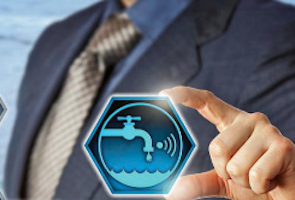
Smart water technology
March 26, 2020
By Paul Laughton, P.Eng.
The Internet of Things (IoT) offers many benefits for water management.

Image credit: sleowolfert – stock.adobe.com
Water is, without question, our most precious natural resource. It is essential to life and we cannot function without it. In Canada, many of us are lucky enough to have access to clean water that has been treated for public consumption, thanks to environmental engineering, biology, chemistry, microbiology and public policy.
Water and wastewater treatment facilities are critically important for our communities. They help ensure people thrive in good health and prosperity and our economy runs smoothly.
Today, these facilities can benefit from the Internet of Things (IoT) by using sensors to serve as ‘eyes on everything.’ These devices can extract valuable data, which is then read and analyzed with a connected software platform, for the purpose of detecting patterns and anomalies, making recommendations and alerting users to potential situations before they happen.
Turning water into smart water
For water and wastewater treatment plants, IoT sensors can collect real-time data on water quality, temperature, flow and storage levels, air quality, equipment temperature, humidity, biogas distribution and energy output.
Water meters and intelligent sensors can work together to gather information about total dissolved solids (TDSs), bacteria, chlorine and electrical conductivity. Other strategically placed sensors can detect temperature changes, pressure levels and leakage incidents, sending the information back to a main server, so engineers are alerted and can resolve any issues.
IoT sensors can also monitor water quality through each stage of disinfection treatment, such as chemical levels during chlorination or, when water is being treated with ultraviolet (UV) rays, using flow and UV transmittance data to help optimize output.
The same technology can even help conserve water. Predictive analytics can estimate the amount of water a given city is going to use within a given day, based on historical data, weather and other factors. By knowing what level of consumption is expected, engineers can maintain levels in reservoirs and tanks throughout the day, pumping water into overhead tanks as required.
‘Smart water’ technology is already being used to provide safe and clean water to Indigenous communities in Canada where boil-water advisories had been in place for decades. By improving levels of automation, the use of IoT sensors has reduced human error in communities where water and wastewater overflow events in the past had resulted in costly clean-up and remediation efforts.
Streamlining operations and protecting equipment
IoT sensors can improve efficiency, reduce operational costs and extend the life of a facility’s equipment. Thermal cameras, for example, can detect when equipment is overheating and requires repair, allowing staff to shut it off to prevent a breakdown or dangerous incident from occurring.
By combining collected data with machine learning technologies, an IoT platform can also help predict the maintenance needs of pumps, distribution networks and storage cisterns. Another specific application in wastewater treatment plans is monitoring the flow rate of sludge in grit chambers, which can otherwise strain machinery elsewhere in the process and damage the pumps.
And again, multiple sites can be monitored from a central location.
Network surveillance
The resilience of public water and wastewater facilities calls for intelligent, flexible, reliable and customizable surveillance technology. This may include Internet Protocol-based (IP-based) visual and thermal cameras, radar, door stations and audio equipment.
Such equipment can integrate with other IP-based systems. The technology is scalable and updatable, allowing users to manage multiple sites from a central location, for example, and to futureproof their network.
Network cameras can protect premises without constant staff presence by using intelligent features to analyze monitored situations and then alert users as necessary with direct notifications. An alarm can be raised when, for example, an unauthorized intruder crosses a predefined boundary.
Thermal cameras and radar can detect people, objects, incidents and temperature fluctuations in complete darkness or other challenging conditions. Hardware variations include pan-tilt-zoom (PTZ), fixed-box, dome, modular and even purpose-built explosion-protected cameras for hazardous areas.
Related audio equipment can include two-way and horn speakers that are triggered in response to intruders. The same systems can be used for live or scheduled announcements in different zones.
Protecting workers
Preventing intrusion and possible contamination of water contributes to public safety, but internal safety is another area where IoT-based sensors can play a role.
By way of example, new analytics technologies are now being designed to detect whether or not employees are wearing the proper safety gear. If they are not, an IoT connection can allow a trigger alarm to prevent them from entering a certain area.
Cameras can also trigger alarms for events like chlorine leaks to help prevent workers from coming into contact with toxic substances.
Customizing the system
When considering IoT-based ‘smart water’ technologies for a facility, it is important to consider local factors, including geographic location. Each plant will entail its own unique key assets, vulnerabilities and threats, so each is a unique project. What is the likelihood of something happening, what is the possible impact and are there any existing mitigation strategies?
Insurance is another factor to consider, as underwriters will take everything into consideration when assessing a treatment facility. If the likelihood of having to file a claim is lower, that can work in the plant’s favour, helping to justify an investment in enhancements.
As always, consulting engineers should get involved as early as possible, to provide input the owner may not otherwise consider and to ensure a plant’s specific systems will perform optimally. There is also the opportunity to consider interdependency. If lighting is not appropriately positioned, for example, some cameras may not work as effectively as they should. By getting involved at the beginning of a new build, engineers can help determine such interdependencies and make the process more cost-effective.
Paul Laughton, P.Eng., is architect and engineering manager for Axis Communications, where he supports both internal employees and external customers in designing smarter security systems. For more information, visit www.axis.com.